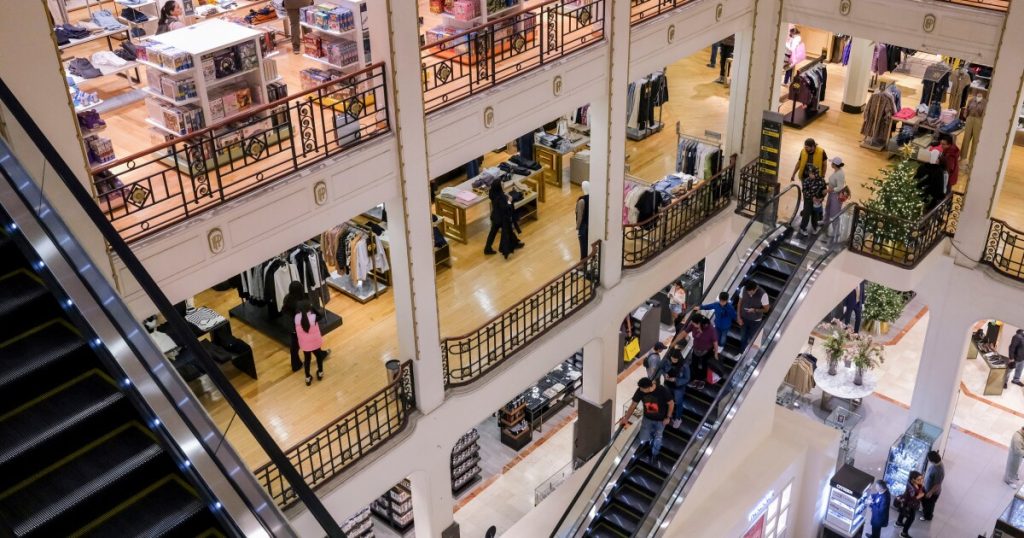Stephania Corpi/Bloomberg
Gen Z and millennial shoppers helped drive buy now/pay later adoption to new heights this holiday season as the prolonged effects of inflation pressured budgets. The greater volume is also a signal of increased consumer confidence.
Broadly, BNPL usage logged a 23% year-over-year gain as of Nov. 20 as consumers turned to small lines of credit to extend their budgets, said Kevin King, vice president of credit risk at LexisNexis Risk Solutions.
“The growth is no longer necessarily being fueled by new users, so much is being fueled by existing buy now/pay later customers that say, ‘I really like this experience and I want to turn to buy now/pay later more often for my credit needs.'”
In fact, 94% of BNPL transactions in November were from previous customers that have used the product, up from 91% in the same period in 2023, King said, noting that half of BNPL consumers were under the age of 35. By comparison, two-thirds of credit card users are over the age of 35, he said.
“When you contrast the age adoption of buy now/pay later and credit cards, it’s pretty clear [BNPL] is a tool that’s preferred by younger consumers [and by] consumers that have either less established credit histories or less prime credit histories, because the interest rates and late fees are lower,” King said.
A majority of younger consumers are using BNPL, with 62% of Gen Z consumers and 56% of millennials saying they’ve tapped the product, according to the TSG and Electronic Transactions Association’s fifth annual
At BNPL provider Zip Co., millennials were the primary shoppers during the Black Friday and Cyber Monday weekend, followed closely by Gen Z, U.S. CEO
“The general premise here is like there’s some consumer confidence,” Heck said. “We’re seeing more and more Gen Zs roll through. We start to see this anti-debt trend in younger generations. Buy now/pay later [products] are a simple way to create the flexibility of a credit card but not the potential for long-term debt revolving.
“I think we’ll see more of that, because you’re not beholden to FICO,” Heck said, noting that one survey Zip conducted showed 59% of consumers are using BNPL for holiday shopping.
Black Friday and Cyber Monday are more reinforcement that the consumers are continuing to look for alternatives to credit cards and look for simplicity and transparency in the product, Heck said. “BNPL fits those things.”
Millennials also drove BNPL adoption at Afterpay, Block’s short-term installment product, said Tanuj Parikh, head of global partnerships at Afterpay and Cash App.
“Afterpay transactions this past Black Friday/Cyber Monday grew 10% year on year versus the same period in 2023,” Parikh said. “The demographic trends squarely align with what we see broadly for us in the category, which is that millennials were sort of the most prominent there, at about 44% of the spend, followed by Gen Z at 26%.”
Block processed 144 million transactions across Afterpay, Cash App and Square during the Black Friday/Cyber Monday weekend, with online shopping posting 21% growth, and in-store logging 17% growth, Parikh said. Online cart sizes were twice as large as they were in the prior year, he said.
The increase in BNPL volume comes as consumers grapple with dwindling savings spurred by
“We’re seeing increases over the holidays [in BNPL],” Kooi said. “I think some of that goes with the same things that you’re hearing from financial institutions around their balance sheet management and their deposits and that their customers’ or members’ savings are being eroded because of inflation. Buy now/pay later I think is showing up more this holiday season because of those trends and being utilized more because of those trends.”
In fact, 38% of shoppers said they were stressed about holiday shopping this year, according to Afterpay’s
Still, the increase in BNPL activity signals an increase in consumer confidence, Zip’s Heck said.
Thanksgiving to the middle of January marks the heaviest period of consumer spending, so much so that Visa — whose fiscal year starts Oct. 1 — uses it as a barometer to plan the rest of its year, said Elias Ghanem, global head of Capgemini Research Institute for Financial Services. Ghanem spent 12 years at Visa and four at PayPal.
“Nobody knew how 2024 would be, so everyone went soft on spending,” Ghanem said. “I think Americans are optimistic about 2025. If we look at the stock market, everything is going in the right direction. So if I’m optimistic about the future, I can spend now and pay later.”
BNPL’s growth this
“The whole thing with buy now/pay later was, ‘Is it viable? Are these companies?'” Hilt said. “I can’t see anything that’s saying it’s not. It is viable. There’s repeat purchases. There’s broad usage, which is what you want.”
Hilt compares the industry dialogue around BNPL to the beginnings of credit cards. “Years back, [the question was] ‘Is credit going to revolve?’ We’ve answered that question,” he said. “The answer is yes. Its repeat users, people pay it off, they revolve, it’s all over the place. Each individual will decide how they consume based on their individual needs.
“Buy now/pay later is the same thing. I use it for this niche. It’s in addition to other form factors and lines of credit,” Hilt said.
Zip’s Heck believes there’s a ton of growth ahead for BNPL. “I think that swim lane is still going to get bigger for BNPL as consumer adoption takes [hold],” he said.
“We’ll see how the market continues to mature in the U.S., but there’s a ton of upside still left,” Heck said.
